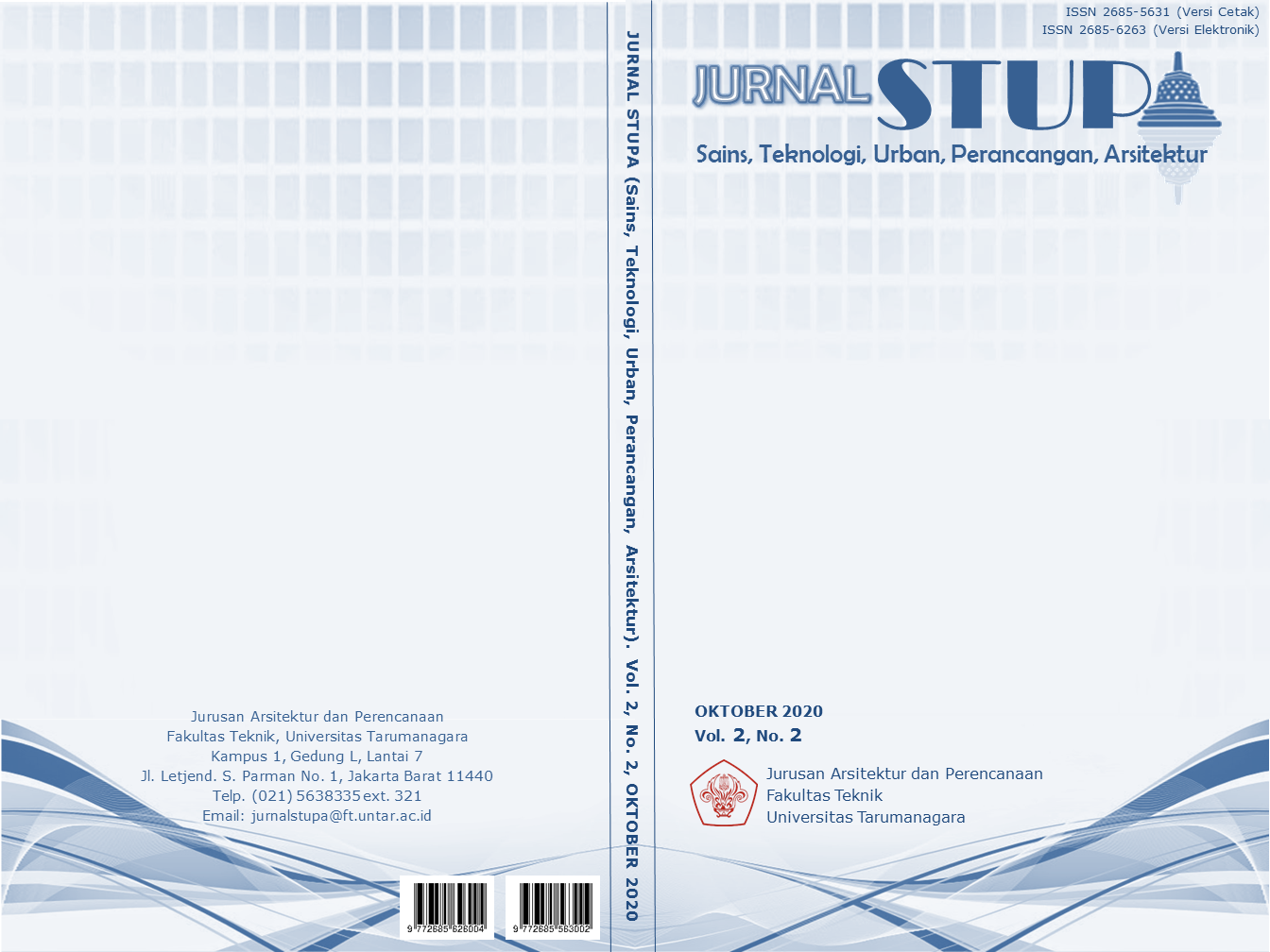WADAH KREASI DAN REKREASI DI CENGKARENG TIMUR
Main Article Content
Abstract
In todays modern era, the development of industry and commerce is extremely potent, producing lots of factories, and shops ranging from large scale to micro scale. An example of the district that is known to develop in this field is East Cengkareng located in west of Jakarta.This district, this area is packed with activities, from commerce and production, ranging from big to medium to micro business. On the other hand, this district also packed by middle rank to lower rank residential, proven from the concentrated small housing despite its high-density population. The consequences of highly concentrated activities in commerce and industry is a less developed facilities and categorized as a district with the highest Environmental and health problem in Jakarta. Through observation, data collection, and interviews, the advice, and aspirations of the residents are collected and reorganized based on third place theory and nest concept producing Creation and Re-Creation Building in East Cengkareng as a building designed entirely based on the needs of the residents around to talk, relax, relieve stress, and yet remain productive. This third place encourage people to recycle and remake trash actively. Through this activity, people can increase their life’s qualities and develop their potential, socially or skillfully. This building itself is made from many kinds of trashes such as waste plastic bottles, paper scraps, wood pieces, and others that are recycled and remade into a functional and comfortable building; in other words, this building is a ‘masterpiece’ on its own built with trashes.
Keywords: architecture; east cengkareng; facilities; papercraft, third place
Abstrak
Di era modern ini, perkembangan industri dan niaga sangatlah pesat, menghasilkan banyak pabrik-pabrik and toko-toko dari yang berskala besar hingga mikro. Salah satu contoh wilayah yang berkembang dalam bidang ini adalah Cengkareng Timur yang terletak di Jakarta. Wilayah ini memiliki aktivitas yang sangat padat, mulai dari perdagangan, produksi, mulai dari usaha besar, menengah hingga usaha mikro. Dilain sisi, wilayah ini juga padat akan pemukiman menengah dan kebawah, terlihat dari padatnya bangunan dan penduduk. Sebagai akibat dari tingginya fokus dan aktivitas masyarakat di bidang industri dan niaga, wilayah ini kekurangan fasilitas sosial dan terkategori sebagai wilayah dengan Indeks Kerawanan Lingkungan dan Kesehatan (IKLK) tertinggi se DKI-Jakarta. Melalui observasi, pengumpulan data, dan wawancara, data-data dan kebutuhan serta aspirasi masyarakat dikumpulkan dan dikelola menurut teori third place dan nest concept, sehingga menghasilkan Wadah Kreasi dan Rekreasi di Cengkareng Timur yang didesain sepenuhnya berdasarkan kebutuhan masyarakat Cengkareng Timur untuk bercengkrama, bersantai, melepas penat, dan mengisi waktu luang, namun tetap produktif. Third place ini mengajak masyarakat untuk turut aktif dalam mengolah sampah terutama sampah kertas. Melalui aktivitas ini seseorang/masyarakat dapat meningkatkan kualitas hidup dan potensi dirinya, secara sosial, maupun keterampilan. Bangunan ini sendiri dibuat dari berbagai macam sampah seperti botol bekas, kertas sisa, kayu bekas dan lain-lain yang diolah Kembali dan dibentuk menjadi sebuah bangunan yang fungsional dan nyaman, dengan kata lain bangunan ini adalah ‘mahakarya’ yang terbuat dari sampah.
Article Details
References
Altman, I. (1975). The Environment and Social Behavior: Privacy, Personal Space, Territory, Crowding. Monterey: Brooks/Cole Publishing Company.
Arsyad, L. (2004). Pengantar Perencanaan Pembangunan. Yogyakarta: Media Widya Mandala.
Ayudiana, S. (2019). "Benarkah Kerajinan Kertas Bisa Meredam Stress?". Retrieved Februari 10, 2020, from https://www.antaranews.com/berita/810223/benarkah-kerajinan-kertas-bisa-meredam-stres.
BPS. (2019). Cengkareng Timur dalam Angka 2019. Jakarta: Badan Pusat Statistik jakarta Barat.
Csikszentmihalyi, M. (1990). Flow: The Psychology of Optimal Experience. Pennsylvania: Harper Perennial.
Goble, F. G. (1970). The Third Force: The Psychology of Abraham Maslow. Michigan: Grossman.
Halim, D. (2005). Psikologi Arsitektur: Pengantar Kajian Lintas Disiplin. Jakarta: Grasindo.
Katyal, N. K. (2002). Architecture as Crime Control. The Yale Law Journal, 111, 1039-1137.
Oldenburg, R. (1989). The Great Good Place. Boston: De Capo Press.
Osmond, H. (1957). Function as the Basis of Psychiatric Ward Design. Psychiatric Services, 8 (4), 23-29.
Shah, R. C., & Kesan, J. (2007). How architecture regulates. Chicago: University of Illinois.
Sjarief, R., & Hidayat, A. (2019). Methodgram: Methodology Grammar. Jakarta: RAW Press.
Whyte, W. H. (1980). The Social Life of Small Urban Space. Washington D. C.: Conservation Foundation.



